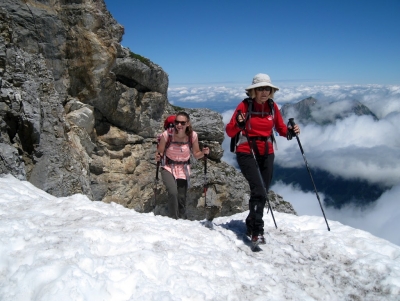- Trips
- Tour Calendar
- About Our Tours
- Plan a Trip
- Book a Trip
- About Us
- Contact Us



Alpenwild guides have a knack for making the best out of any weather conditions. We know the escape routes and the passes that offer the best chance of success in inclement weather. We adhere to the motto: "Life isn't about waiting for storms to pass. It's about learning to dance in the rain." And we know where to go and how to have a great time in the worst of weather.
We also stay closely tuned to changing weather forecasts. On a guided or self-guided hike in the Alps, you may also want to keep up with the forecast in English by checking Meteoswiss, or by calling 162 for day-to-day forecasts in German, French, or Italian.

Summer hiking weather in the Swiss Alps, whether you're in the Jungfrau, the Pennine Alps, the Engadine, or the Mont Blanc Range, is generally very pleasant; and while you may walk in short sleeves under sunny skies on some days, we can almost guarantee that there will also be some days that are cool and wet, especially at higher elevations. The area around Zermatt in the Pennine Alps receives less rainfall than the Jungfrau to the north, because the mountains create a rain shadow. Temperatures can range from the low 40s at night to 80 °F during the day. Along the Walker's Haute Route, hikers can expect daytime temperatures in the 70s in the valleys and in the 50s or 60s above 8000 feet—although it's not uncommon to have freezing rain or snow on the high trail one day, and T-shirt weather at the 9500-foot pass the next.
As for seasonality, the Jungfrau region is ideal for hiking from mid-June through mid-September, while the Hiker's Haute Route, with its high passes is often snowbound until early July. Therefore we typically schedule our first Haute Route trips starting the first week of July and conclude by September 15. Wildflowers on the Haute Route are at their peak in late July and early August, and even earlier in the Jungfrau. For early season (May and June) you'll find wonderful opportunities in the lower elevations of Appenzell's Alpstein mountains, and in the southerly sun-drenched slopes of Ticino and the Engadine.